There is many types of climbing holds and terms to remember. But don't worry, it will be quite easy to do so as the names make lot of sence. This is an overview of the various holds and ways of holding them. You can also visit our climbing holds page to se images of the various colors and shapes.
Jugs are named this way because the hold is literally like a jug with its positive surface and easy-to-grasp shape. The big opening is easy to hold, and climbers often rest on this hold since all of their fingers are secured on it.
How to hold: Simply curl your fingers into the opening and pull. You can also use the friction of your palm between the top of the hold to make you fingers rest a bit. Climbers often match on jugs as well, since there's plenty of space for both hands.
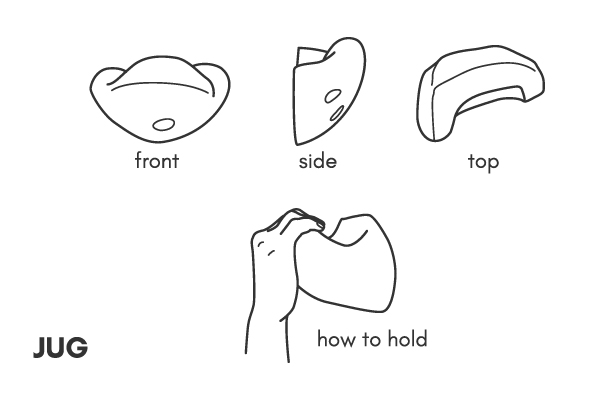
A crimp is a small edge where only one or two pads of your fingers get to touch the surface. Beginners have a hard time using this type of holds because their fingers have not yet been trained to do so, therefore a proper training is required to master crimps. But these holds doen't have to be useless if you can't hold them, they can serve as good footholds.
How to hold: When you crimp, make sure that your body weight is closer to the wall so that less strain is inserted on to your fingertips. This type of hold can stress your fingers a lot so make sure to be careful and go fast for another hold right away.
3 types of Grip Technique
Open crimp: Used on all crimp sizes and especially when the edge of the crimp is rounded. The safest way of holding crimps and thus should be the only way for beginners to hold crimps.
Half crimp: Used on medium sized crimps and small crimps if you are not strong enough yet. The four fingers get partially bended and create a 90° angle between second amd thirs pad. This allows to create more pulling pover than open crimp.
Full crimp: Used on the smallest holds. Put the thumb on top of the other fingers. Effectively, this adds another finger on the hold, so you can pull down more. The first pad of the four fingers is being overextended, therefore high strain is put on the tendons and pulleys in the fingers and the palm. Don't use this kind of technique as long as you are not very experienced as this tecnique is the most common source of injury in climbing!
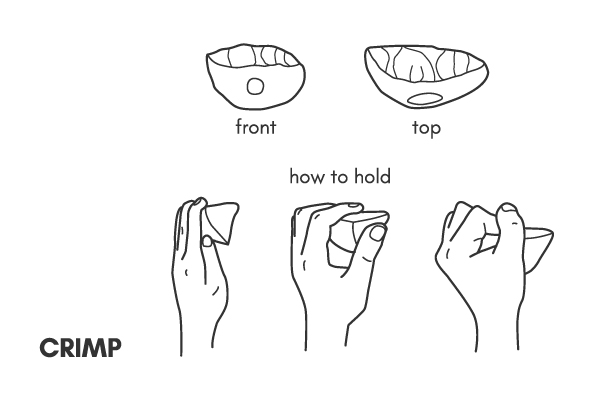
Slopers are rounded and smooth holds that are usually larger in size, with no positive edge at all. They are commonly used for more advanced walls and routes. Climbers rely on the textured surface of a sloper to get friction and stabilize on the hold.
How to hold: Good technique is needed to be able to use slopers successfully. With an open grip, place a hand on a sloper and make sure that maximum of the hand is in the contact with the hold in order to be able to create enough friction to hold it firmly. Most important in using slopers is a good body positioning during climbing, where you want maximum of you body weing being exactly in the direction of the pull. If the body gets away from the wall, sloper will most likely slip off. Because of its size, slopers are also great for mantles, or for easy foot matches.

A pinch is literally a hold that is used by pinching one side with your thumb and the other your fingers. It’s tricky for beginners since their grip strength is not yet that strong but they can test it on larger holds first.
How to hold: The positive sides of a pinch are usually positioned vertically, so make sure you squeeze the hold securely and lock it in like a crab’s claw. You can practice on grip strength tools to build up the pinch strength.
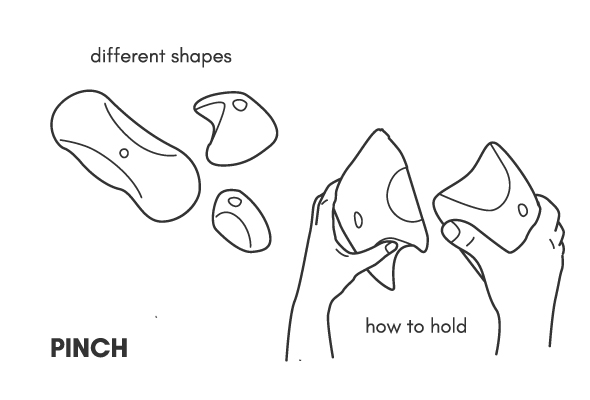
A pocket is usually a round hole that allows 1 to 4 fingers to get in. It can be tricky to get and use the hold right as accuracy as well as high finger strenght is required.
How to hold: Try to jam as many fingers as you can in the hold and pull. The middle and ring finger are usually the strongest for two-finger pockets, but some people prefer index and middle finger instead. It takes time to master your finger strength so this hold might be tricky. You may opt for hanging using only your fingers or just a few of them on a hangboard, as that is the safe way to try using less fingers. But be careful, one- and two-finger pockets can create a huge straing on the fingers and cause an injury.
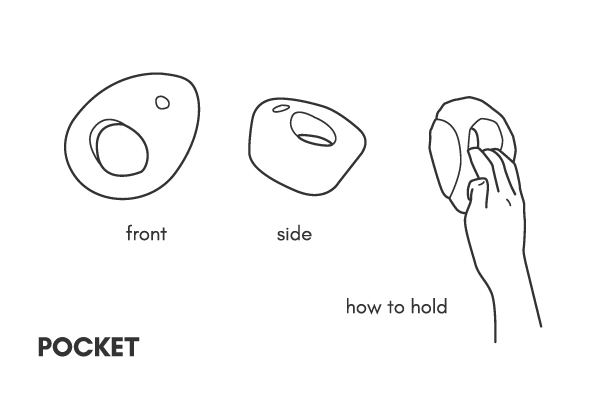
An edge is the in-between a crimp and a jug. The positive edge is not as big like as that of a jug, but at least you can fit four of your fingers and more pads unlike a crimp.
How to hold: You can use the edge either like a crimp, with a close grip where your fingers are tightly close together; or like a jug with an open grip, but it does not feel as secure though you can still pull it off.
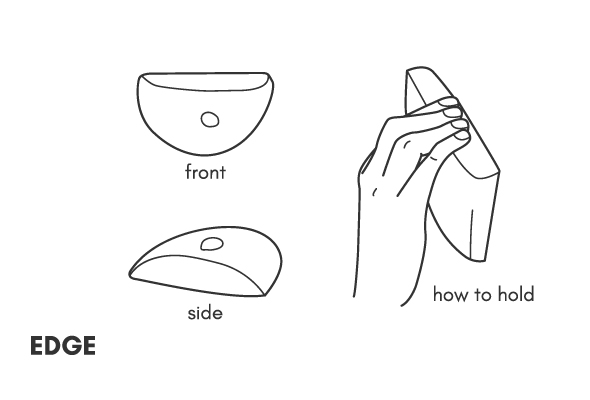
A few more types of climbing holds and ways of holding them
Crack - it can be a good hold if you can jam a bodypart into the crack, from fingers to toes and fists. There is many techniques for crack climbing.
Flake - a long piece of rock that has an edge and is visibly sticking out from the rock and looks simmilar to a crack. It is usually a good hold.
Gaston - a kind of grip which involves pushing a hold instead of pulling. You need to turm a palm away from you, with the thumb pointing down and the elbow out, and generate friction against the hold by pressing outward toward the elbow. Visualize it by imagining how you would pull open an elevator door.
Jam - any piece of a rick where you can jam a given part of your body.
Mono - a hiold that ony one finger fits in.
No-hand rest - a resting position where you can release both hands. You can usually achieve this while having a kneebar or by standing on a ledge
Rest - a position, where you stop climbing and rest. Hold is better thean the rest and it gives you some time to partinally recoved
Sloper - a flat hold that is usually smooth and rounded with shard edges. You hold it with a palm and fingers.
Undercling / undercut - any tipe of hold that is facing down. You usually have to hold it quite low and use lots of biceps to stand up.
Side-pull - any tipe of hold that is turned sideways. You have to pull from the side towards your body to put a force on it.
Tufa - a rock feature that is usually found in overhangs. It is created by condensating minerals and it is long. You usually have to pinch it. Tufas can be often combined with stalactites and other features found in caves.
Volume - an artificial big feature / hold in indoor gyms. It if often created from plywood and it makes the climbing wall more 3D. In modern climbing, it often serves as a good hold to create boulders for smearing and body balance

















